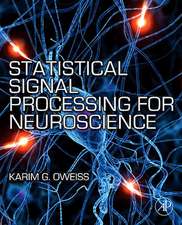Bipolar Disorder Vulnerability: Perspectives from Pediatric and High-Risk Populations
Editat de Jair Soares, Consuelo Walss-Bass, Paolo Brambillaen Limba Engleză Paperback – 12 iun 2018
Whereas most of the literature available on the pathophysiological mechanisms of bipolar disorder focuses on chronically ill adult individuals, this represents the only book that specifically examines pediatric and high-risk populations. An estimated 30 to 60 percent of adult bipolar disorder patients have their disease onset during childhood, with early-onset cases representing a particularly severe and genetically loaded form of the illness.
- Highlights diverse translational methodologies, including functional and structural neuroimaging, neuropsychological testing and integrated genomics
- Examines molecular trajectories in youth with bipolar disorder and unaffected youth at high risk for developing bipolar disorder
- Explores the interaction between genomic and environmental influences that shape behavior
Preț: 500.82 lei
Preț vechi: 625.70 lei
-20% Nou
Puncte Express: 751
Preț estimativ în valută:
95.86€ • 104.16$ • 80.58£
95.86€ • 104.16$ • 80.58£
Carte tipărită la comandă
Livrare economică 14-28 aprilie
Preluare comenzi: 021 569.72.76
Specificații
ISBN-13: 9780128123478
ISBN-10: 0128123478
Pagini: 288
Dimensiuni: 191 x 235 x 17 mm
Greutate: 0.57 kg
Editura: ELSEVIER SCIENCE
ISBN-10: 0128123478
Pagini: 288
Dimensiuni: 191 x 235 x 17 mm
Greutate: 0.57 kg
Editura: ELSEVIER SCIENCE
Public țintă
Advanced students, researchers, and clinicians in biological psychiatry, psychiatry, psychology, behavioral neuroscience, and related disciplines interested in risk factors for mental illnessCuprins
1. Presentation and prospective course of pediatric bipolar disorder
2. The Bipolar Prodrome
3. Animal models of the bipolar prodrome
4. Polygenic risk in family members of patients with bipolar disorder
5. Gene-Environment interactions in high-risk populations
6. Influence of early childhood trauma on the prodrome of bipolar disorder
7. Neurobiological markers of stress in youth at risk for bipolar disorder
8. Neuroimaging findings in youth at risk for bipolar disorder
9. Neurocognitive findings in youth at risk for bipolar disorder
10. Neuropsychological and social cognitive function in young people at genetic risk for bipolar disorder
11. Behavioral and emotional dysregulation trajectories in symptomatic youth
12. Cognitive and neural basis of hypomania
13. Early pharmacological interventions to prevent full onset of bipolar disorder
14. Psychotherapeutic interventions
15. Summary and integration of current findings: A model for Bipolar Disorder Development
2. The Bipolar Prodrome
3. Animal models of the bipolar prodrome
4. Polygenic risk in family members of patients with bipolar disorder
5. Gene-Environment interactions in high-risk populations
6. Influence of early childhood trauma on the prodrome of bipolar disorder
7. Neurobiological markers of stress in youth at risk for bipolar disorder
8. Neuroimaging findings in youth at risk for bipolar disorder
9. Neurocognitive findings in youth at risk for bipolar disorder
10. Neuropsychological and social cognitive function in young people at genetic risk for bipolar disorder
11. Behavioral and emotional dysregulation trajectories in symptomatic youth
12. Cognitive and neural basis of hypomania
13. Early pharmacological interventions to prevent full onset of bipolar disorder
14. Psychotherapeutic interventions
15. Summary and integration of current findings: A model for Bipolar Disorder Development






















